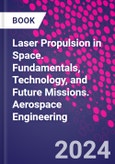Space launches have evoked the same vivid image for decades: bright orange flames exploding beneath a rocket as it lifts off and thunders into the sky. An alternative acceleration system could reshape that vision forever, with rockets leaving their energy source on the ground... or in space.
Laser Propulsion in Space: Fundamentals, Technology, and Future Missions takes readers on a comprehensive journey from the theoretical overview of propulsion fundamentals, to reviews of current projects involving high-power CW fiber lasers and energetic mm-wave sources with their ongoing and potential end-use applications in beamed energy propulsion (BEP). Written by experts in the field, this mathematically sound reference text also highlights graphical solutions of equations’ results, as well as case studies with worked-out examples, making this book an invaluable compendium for students, researchers, technology developers and futurists in understanding the promise and challenges of this emerging technology.
Please Note: This is an On Demand product, delivery may take up to 11 working days after payment has been received.
Table of Contents
1 Basic theory of laser propulsion2 Breakthrough Starshot program overview
3 Starshot system model
4 Space situational awareness: the potential role of lasers in long-term sustainability of space operations
5 State of the art in high-power lasers
6 High-power laser engines
7 Large scale directed energy
8 The ways to improve momentum and kinetic efficiency of laser propulsion
9 Laser-driven, In-Tube Accelerator (LITA)
10 Fly by light
Authors
Claude Phipps Managing Partner, Photonic Associates, LLC, Santa Fe, New Mexico, USA..Claude Phipps earned B.S./M.S. degrees at MIT and a PhD at Stanford in 1972 for the first laser-plasma interaction experiment. At Los Alamos from 1992 to 1995, he facilitated peaceful applications of lab technology as Associate Director of the Alliance for Photonic Technology, was project leader for the Laser Effects Program, and developed a general theory for predicting pulsed laser pressure on surfaces in vacuum. In 1995, he founded Photonic Associates to develop laser space propulsion. He invented the ORION and L'ADROIT concepts for laser space debris re-entry and collaborated with CNES to develop the Just-in-time Collision Avoidance principle. He has authored 145 scientific journal publications on laser applications and material interactions and 168 conference presentations. He chaired the 'High Power Laser Ablation' conferences in Santa Fe from 1998 to 2024. He is the author or contributor to three books on laser interaction and a popular science book titled No Wonder You Wonder (Springer, 2016).








